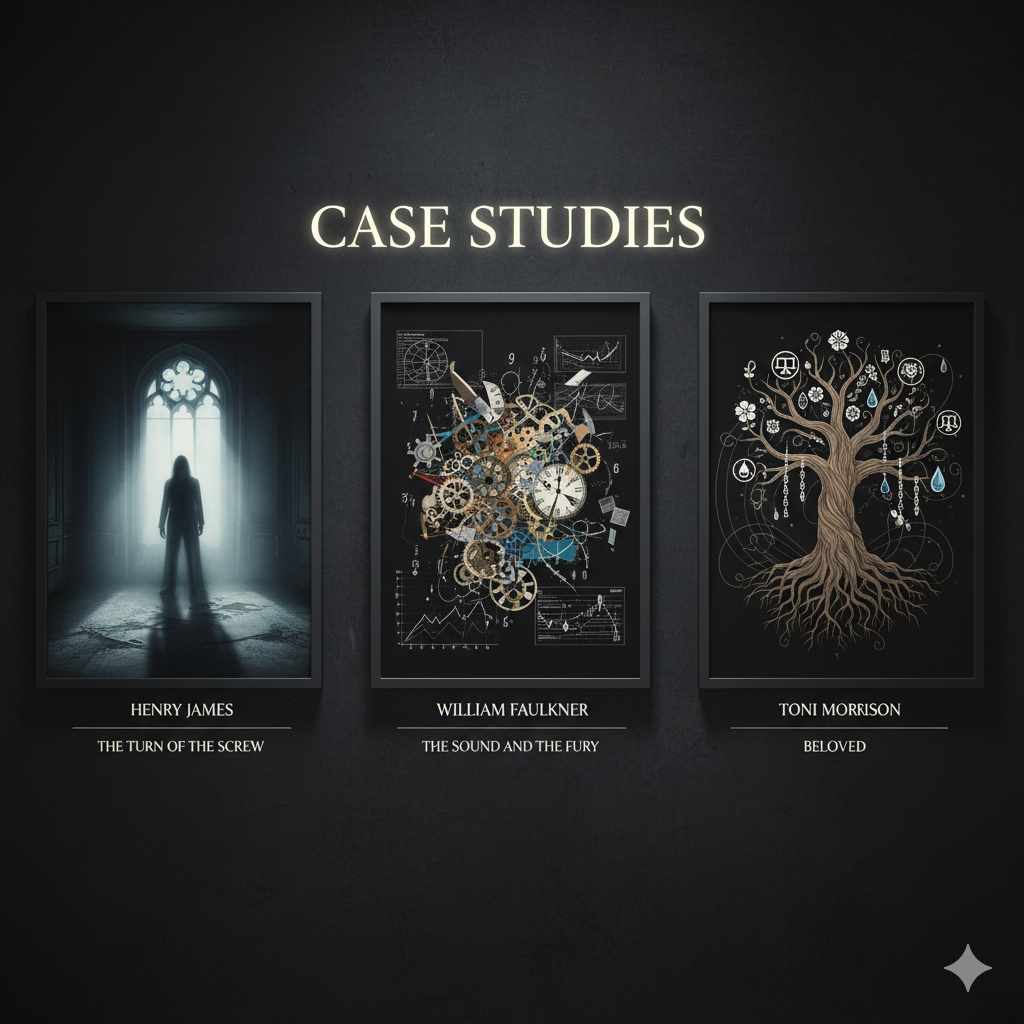- Deep reading requires time, focus, and a deliberate mode of engagement. It depends on the reader’s decision to move beyond plot and attend to how fiction organizes tone, pacing, and thought.
- Literary attentiveness transforms reading into an active, structured practice. This involves observing how perception is managed on the page—how the novel controls what is seen, when it appears, and how it connects to what precedes or follows.
- Writers guide attention through:
– narrative voice
– selection and placement of detail
– variation in pacing - These elements do not support the text passively; they direct its movement and coherence. Perception, in this context, functions as part of the narrative method. It allows the reader to follow how a novel builds continuity, controls emphasis, and sustains internal logic.
- When attention is sustained at this level, reading becomes an intellectual exercise with its own discipline and reward.
Literary attentiveness demands an act of will: the reader elects to engage with the narrative beyond mere plot, attending instead to subtle modulations in tone and the rhythmic unfolding of thought. Such reading requires a disciplined application of intellect, a quiet perseverance that allows the subtler frequencies of the text to become audible.
This article examines literary attentiveness within fiction and its effects on the discerning reader. With a critical perspective, it clarifies what transpires when one approaches fiction as a deliberate instrument of intellectual engagement. The ensuing analysis articulates how deep reading becomes a cultivated practice, transitioning from a mere activity into a rigorous, formative engagement with the constructed world of a narrative.

The Nature of Literary Attentiveness
Literary attentiveness originates with a conscious realignment in the reader’s mode of engagement. It arises from an intentional posture rather than a passive reception of text. The sentence, released from its role as mere information delivery, becomes a confluence of authorial decisions. The paragraph, freed from the obligation to advance the plot, becomes a narrative design where the author’s and the reader’s consciousness meet.
Casual Reading vs. Deep Reading
The difference between casual reading and its deeper counterpart becomes apparent through the intensity of focused attention. Casual reading processes events and gathers surface information; deep reading traces thought, tone, and spatial arrangement. When the reader approaches a sentence without rushing toward final determination, a subtle dialogue between the reader and the novel begins.
Deep reading, furthermore, alters cognition by engaging the reader in a reflective encounter. The intentionality of literary attentiveness guides the reader toward subtleties that remain unseen under hurried conditions or with casual reading. This curiosity and patience create the conditions for genuine engagement. The mind steadies itself, recognizing that interpretive wealth is proportional to the time spent perceiving the underlying architecture of the prose.
This mode acknowledges the complexity of the fictional structure, treating the text as a system of relationships. Each scene gathers dimension when previous passages remain foregrounded, re-contextualizing all that has come before. The objective shifts from knowing what happens to discerning how the happening is rendered, a focus that ultimately clarifies the work’s intellectual and structural architecture.

Conditions for Deep Reading
Deep reading flourishes when the reader allocates continuous, undisturbed time. For instance, a novel reveals its internal structure when the reader moves through it without haste; the narrative’s full power becomes apparent when granted the luxury of slow, cumulative exposure. As the reader remains present with the work, interpretation becomes more coherent. Without this commitment, important aspects remain hidden, as they require time to emerge.
Deep reading also requires a form of internal calibration. The reader must consciously still the mind’s tendency to wander. With conscious narrowing of mental focus, the page commands the entire field of consciousness. This mental posture elevates reading from a passive reception to an active, analytical operation.
Attention as a Mode of Inquiry
When a reader engages with a work of fiction, attention immediately transforms into a mode of inquiry. A novel effectively calls upon the reader to observe patterns of tone, gesture, and moments of omission—a process that unfolds through the slow recognition of recurring motifs and the arrangement of images across the page. This gradual accumulation of details makes the narrative unfold organically without relying on explicit authorial explanation.
This type of focused attention clarifies how the narrative develops its interior tension. It shows how an author relies on subtle shifts of perspective to guide interpretation, with the reader beginning to grasp that the efficacy of a novel depends entirely on how one perceives its movements, rather than on what the plot delivers alone. Interpretive quality grows significantly when the reader detects connections that move beneath the surface of the plot, sensing the full presence of a thematic structure that is only intimated by the story’s surface action.

The Requirement of Intentionality
Deep reading is an elective expenditure of intellectual resources, not a constant mandate for all engagement with written material. The analysis articulated here focuses only upon works whose architecture merits and rewards focused attention. Not all prose is structurally designed to withstand or profit from this level of scrutiny. Rather, deep reading is reserved for literature where the author’s structural intent is demonstrably complex and embedded in the very form of the text, rather than simply its subject matter.
The Demand of the Text’s Structure
The requirement for attentiveness is fundamentally structural. Certain fictional arrangements inherently demand cognitive intensity for genuine comprehension. Consider the structural differences between two distinct forms of prose. A work like Fyodor Dostoevsky’s Crime and Punishment (1866) or Virginia Woolf’s To the Lighthouse (1927) necessitates deep reading because their primary argument resides in subtle shifts in psychological perspective and intricate, recursive patterning. Each of their narrative structures becomes the primary cognitive obstacle, yielding its full intellectual return only through sustained focus with minute textual variations and pressures.
Conversely, other fictional works are designed primarily for high velocity or transparent communication. Their structure actively minimizes subtextual relationships to facilitate immediate, seamless consumption. This prose perfectly fulfills its purpose—often one of immediate entertainment or relaxation—without demanding the same cognitive investment because its primary components are readily available on the surface. For these texts, a surface reading is not deficient; it is the appropriate mode for their design.
The Utility of Selective Attentiveness
The value of deep reading is not a generalized virtue but a necessary method for extracting embedded meaning. It is a procedure required for works that do not yield their full structure easily. The decision to apply literary attentiveness is, therefore, a critical calibration of the reader’s effort against the potential yield of the text.
The thesis of this entire article is bounded by the condition of the text: deep reading is required when the text is complexly formed, when the arrangement of language carries significance equal to, or greater than, the events described. This selective practice ensures that the reader’s intellectual labor is strategically deployed to understand the most sophisticated and nuanced forms of literary works.
How Fiction Guides the Reader’s Attention

This kind of fiction directs the reader’s focus through choices in tone, pacing, and structure. These elements dictate how information is presented and received. A scene’s significance is seldom announced; it is implied through its rhythm and its position within the broader narrative. A consistently attentive reader learns to detect these implied instructions.
Tone acts as a primary guide. When observed closely, a shift in tone signals a change in its fundamental posture. For example, a tone may shift from ironic to sincere or from detached to intimate. Similarly, the pacing of a passage signals intention. Sections that slow down suggest that the text demands closer inspection, while rapid sequences typically push the story forward or underscore a turning point.
Writers repeat certain structures to forge stronger connections within the text. This helps the reader to tie together disparate patterns in the story and to anticipate subsequent developments. As more relationships between sections become clear, the reader no longer waits for meaning to be delivered. Meaning emerges from how one part reframes another and from how each passage is positioned within the whole.
Narrative Cues That Reward Careful Reading
The attentiveness of the reader is constantly rewarded by the structural design of sophisticated fiction. Motifs develop across chapters, often planted subtly in an earlier passage as a simple detail, only to echo back later with augmented structural significance. These narrative cues are not random repetitions; they are signals that help the reader understand the text’s structure.
Minor actions or descriptions acquire critical significance when viewed through the lens of prior scenes. An otherwise ordinary object, a particular phrasing, or a specific spatial arrangement functions as a textual marker. Fiction intentionally plants these signals within gestures, objects, or environmental descriptions with a tacit understanding that the astute reader will be able to connect these disparate elements.
Perception as a Literary Experience
Complex fiction does not present events in a neutral order. It constructs perception through the deliberate use of voice and pacing. These elements determine what the reader sees, when it appears, and how it is framed within the larger structure of the narrative. Perception functions as a designed feature of the text, not as a byproduct of content.
Narrative form filters content through selection and arrangement. It determines which details are presented, which are delayed, and which are left outside the frame. These decisions influence how the reader understands each moment and how earlier passages relate to later ones. Perception functions as a technical process that directs attention and distributes emphasis to the text.
In sophisticated prose, perception and interpretation are inseparable forces. The author’s choice in framing a visual detail dictates the resulting thought; the description itself constitutes an interpretive act. The careful reader processes sensory input and simultaneously grasps the conceptual significance the author has conferred upon it. This clarification establishes that the novel’s most significant claims reside within the authorial precision applied to selective details.
Case Studies: Architectures of Attentiveness

The preceding analysis established the cognitive parameters and structural necessity of deep reading. In concluding the discussion, the following are case studies to demonstrate the principles in practice. These examples represent texts whose fundamental intellectual power resides not in explicit statements, but in their complex formal arrangement, demanding that the reader function as an active participant in comprehending their intricate narrative construction.
Henry James’ The Turn of the Screw (1898): The Necessity of Perception
Henry James’ The Turn of the Screw (1898) provides a definitive example of fiction whose structure directly compels deep reading. The text’s primary argument is not found in the superficial events but is entirely lodged within unreliable perception. The governess, as the sole witness and narrator of the story’s apparitions, creates a narrative that is fundamentally compromised. The reader cannot simply accept her account of the ghosts, Mr. Quint and Miss Jessel, as factual reportage.
To process this narrative, the reader must engage in an attentional reversal. Instead of following the plot to see what happens, the reader must scrutinize the prose for the manner in which the event is formally presented. Every descriptive detail, every nervous tonal shift, and every instance of the governess’s subjective certainty must be calibrated against the evidence. Her assertions of supernatural menace are continually tested against the possibility of her own mental instability or delusion.
The textual function of this architecture is to transform the reader into an unwilling epistemologist. The only way to move through the text is by slowing down to analyze the governess’s language—the hyperbolic phrasing, the moments of self-contradiction, and the reliance on suggestion rather than proof. Deep reading here is not a virtue but a procedural requirement, essential for determining whether the text narrates a supernatural tragedy or a psychological deterioration. The novel structurally requires the reader to generate the unstated narrative through an exhaustive analysis of the given prose.
William Faulkner’s The Sound and the Fury (1929): The Demand for Cognitive Synthesis
William Faulkner’s The Sound and the Fury (1929) presents a formal challenge that elevates deep reading from a preference to an absolute necessity. The novel’s opening section, narrated by Benjy Compson, plunges the reader into an undifferentiated stream of consciousness where the temporal order of events is deliberately obscured. The transitions between the present, the recent past, and deep memory occur without warning or structural markers.
The text demands a rigorous cognitive tuning from the reader merely to establish the narrative’s baseline reality. The attentive reader cannot rely on traditional sequential reading but must piece together the temporal sequence and character relationships through the slow recognition of recurring images and verbal motifs. Faulkner places the full burden of narrative organization upon the reader’s intellect, requiring the active sorting of sensory impressions and temporal fragments to reconstruct a coherent story.
This architecture demonstrates the power of rhythm and fragmentation in literary expression. The very cadence of the language, often recursive and dense, compels a pause, forcing the reader to dwell in the moment of transition until the preceding image yields its historical context. The Sound and the Fury thus becomes an extended exercise in perceptual synthesis, wherein the work’s primary intellectual output is the manner in which the event is formally presented.
Toni Morrison’s Beloved (1987): The Synthesis of Symbol and Structure
Toni Morrison’s Beloved (1987) structurally necessitates deep reading by embedding its central historical and psychological concerns directly within its rhythmic prose and symbolic arrangement. The narrative avoids explicit, linear recounting of traumatic history. Instead, the emotional nucleus of the work emerges through iterative phrasing and thematic presentation, demanding the reader to track the development of subtle verbal and visual cues across hundreds of pages.
The structural power of the novel resides in the way it employs a limited number of powerful, recurring motifs (such as the image of the chokecherry tree scar or the descriptions of water) to synthesize apprehension. Far from being mere ornamentation, these details serve as structural signposts, establishing connections between disparate time periods and individual consciousnesses. A careful reading registers these repeated images; their iteration conveys a profound cumulative consequence beyond initial presentation.
This technique transforms the reading into an act of co-composition, where the reader’s sustained attention is required to knit together the fractured historical record. By structuring the narrative around these symbolic anchors rather than conventional plot progression, Morrison compels the reader to engage formally with the text. The novel asserts that the deepest truths about its subject are accessible only through the synthesis of these formally presented, repeated details.
Conclusion: The Expansion of Thought

Literary attentiveness is not simply an elevated reading habit but the disciplined focus applied to prose built for sustained critical analysis. The practice of deep reading, driven by complex fictional architectures, effectively recalibrates the reader’s intellectual and affective rhythms. It constitutes a disciplined dialogue with the constructed world of the narrative, an interaction that ultimately expands the capacity for interpretation. This synthesis is frequently powered by the analytical technique of close reading, which enables the precise examination of textual mechanics.
This focused engagement prepares the mind for a different form of reflection, conditioning it to perceive and process the subtleties of structure and nuance that govern both literary and external experience. This profound cognitive expenditure requires systematization and exteriorization; the emergent ideas generated by careful reading must be transposed from the mental space into the physical structure of the text. The act of formal recordkeeping thus becomes the necessary companion to internal attention.
The disciplined practice of book annotation serves as the physical architecture for preserving these subtle intellectual findings. Annotation is not mere highlighting; it is the tangible procedure that confirms the reader’s presence within the text’s complexity. The act of marking the prose validates the intellectual effort and secures the gains of deep reading, ensuring that the discovery of the unseen architecture of the text is made permanent and available for subsequent critical review.
Further Reading
Cultivating Attention: The Challenge of Reading Great Literature by Dr. Holly Ordway, Word on Fire
How to gain more from your reading by Robert DiYanni, Psyche
Serious reading: how to read with attention and insight by David Didau, Substack




